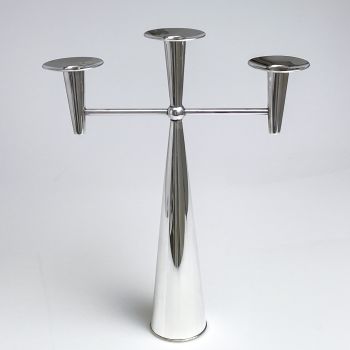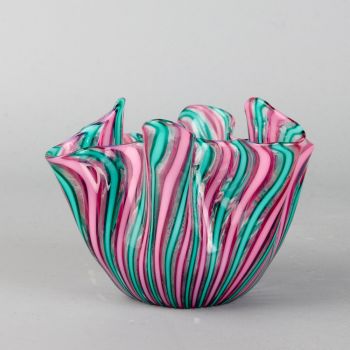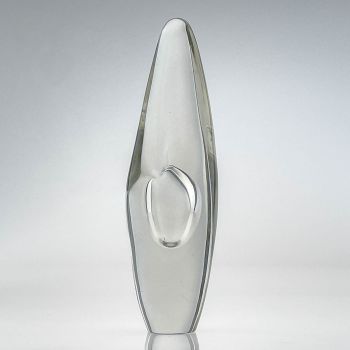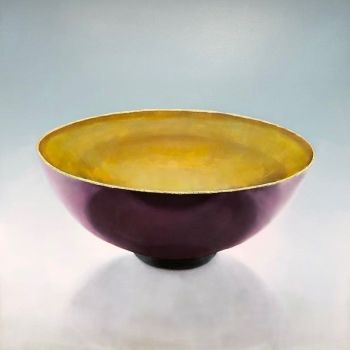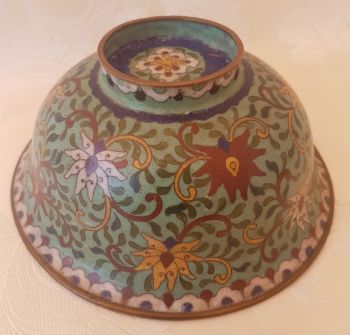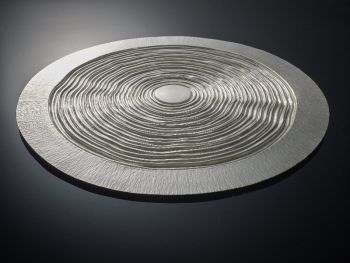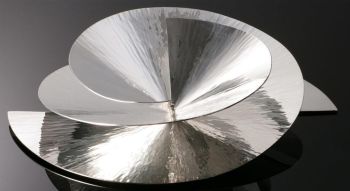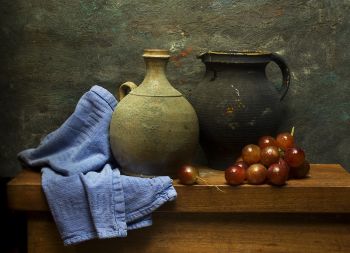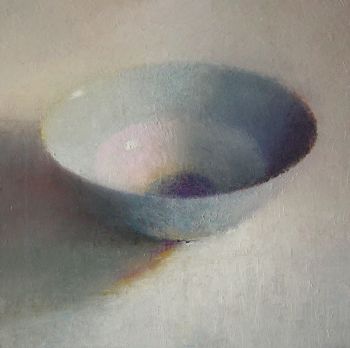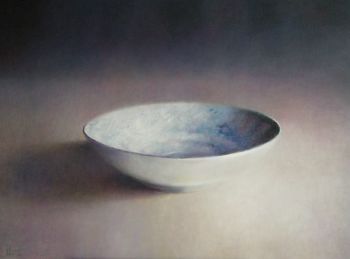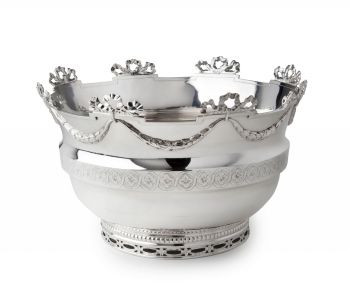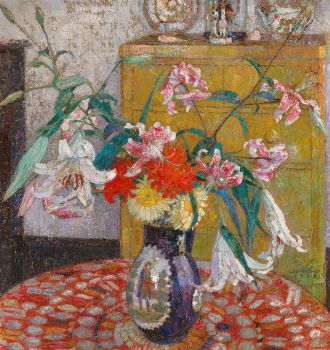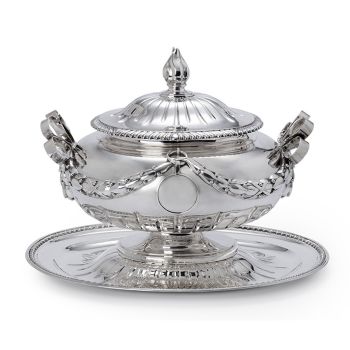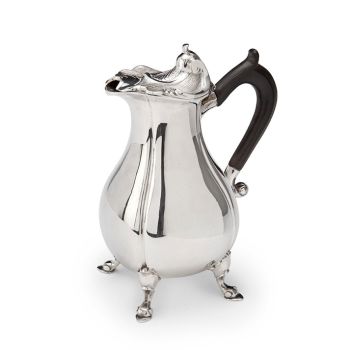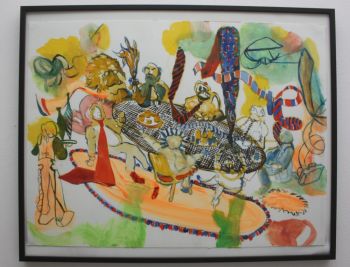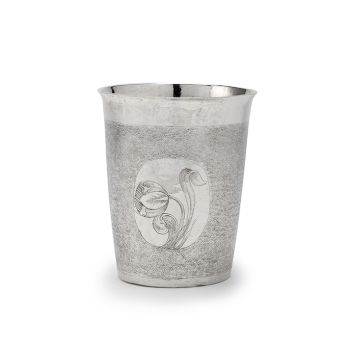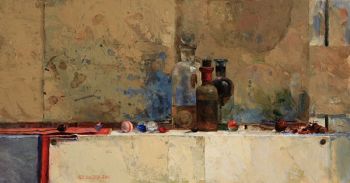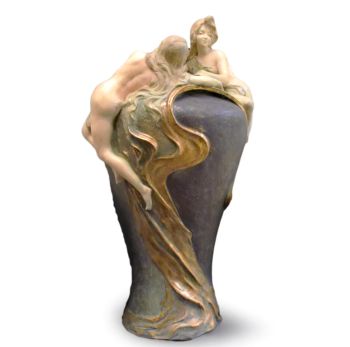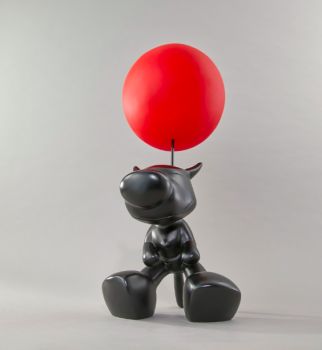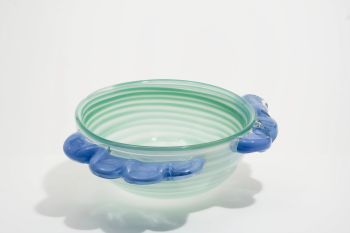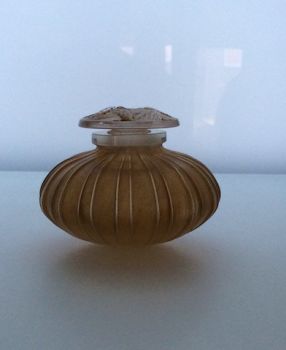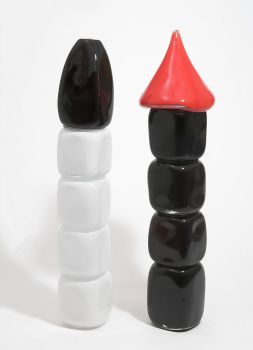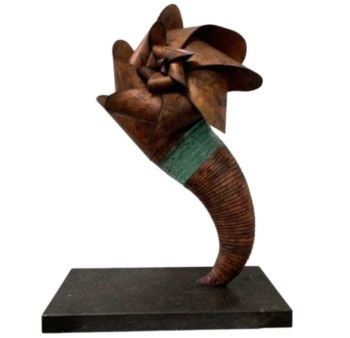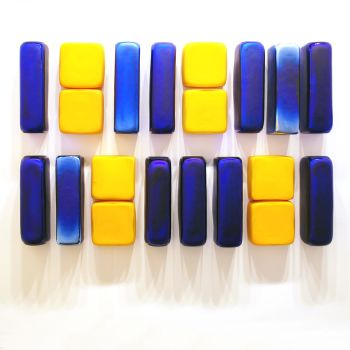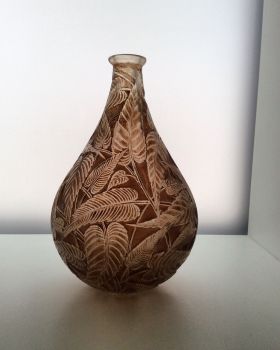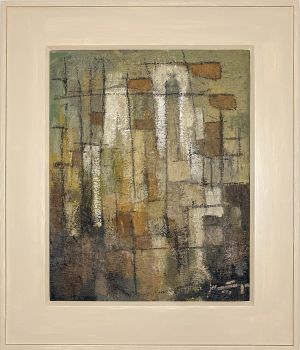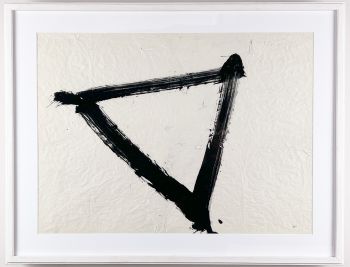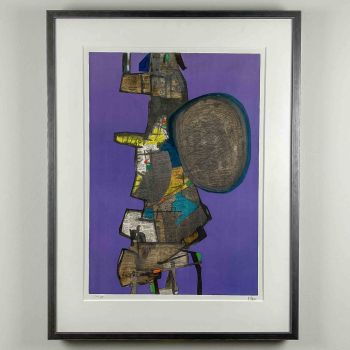Glass art-object, model 531.1M – Venini, Italy circa 1970 1970 - 1979
Tapio Wirkkala
Verre
14 cm, ø 31 cm
ConditionGood
€ 2.000
Van Kerkhoff Art
- Sur l'oeuvre d'artA capital art-object/bowl, model 531.1M, crafted in striking freeblown blue (aquamerine), pale yellow (pagliesco) and black (dark amathist) glass. Designed by the renowned Tapio Wirkkala in 1970, this rare piece was brought to life by the skilled craftsmen of the Venini glassworks on the picturesque Island of Murano in Venice in the 1970's.
This particular object was made using Incalmo, copper wire inclusion and freeblown glass. The copper wire mesh from a distance gives the surface the impression of feathers. The base is formed using pale yellow glass with a black inserted centre. Underneath the black circle the bowl is signed in diamondpen: Venini Italia TW.
About Tapio Wirkkala
Tapio Wirkkala (1915 Hanko, Finland – 1985 Helsinki, Finland) A giant of Finnish design, possessed an extraordinary creative spirit that knew no boundaries. His artistic repertoire traversed diverse materials and transcended conventional design disciplines, leaving an indelible mark on the world of art and craftsmanship.
The trajectory of Wirkkala’s illustrious career was set in motion by a momentous glass design competition held by the revered Iittala glassworks in 1946. It was during this transformative event that Wirkkala, alongside the esteemed Kaj Franck, emerged as the joint recipients of the first prize. This recognition propelled Wirkkala into the spotlight, setting the stage for his remarkable artistic journey.
Wirkkala’s creative genius knew no bounds. His oeuvre spanned a vast spectrum, encompassing exceptionally beautiful glass art pieces, innovative industrial designs such as beer bottles and banknotes, meticulously crafted jewelry, evocative sculptures, and thoughtfully designed furniture. Each creation bore the unmistakable imprint of Wirkkala’s artistic prowess, showcasing his mastery over form, function, and aesthetics.
Throughout his illustrious career, Wirkkala amassed a multitude of accolades, honorary titles, and a doctorate, cementing his position as one of the most revered figures in the design world. His remarkable achievements include three Grand Prix medals at the prestigious Milan Triennale in 1954, followed by yet another Grand Prix medal and gold medal at the Milan Triennale in 1960. These prestigious awards not only celebrated Wirkkala’s unrivaled talent but also underscored his profound impact on the global design landscape.
Wirkkala’s creative journey was an embodiment of innovation, pushing the boundaries of design and challenging conventional norms. His unparalleled ability to infuse beauty into everyday objects and elevate them to the realm of art garnered admiration and acclaim from enthusiasts and experts alike.
Today, we celebrate Tapio Wirkkala as a visionary pioneer who seamlessly merged artistry with functionality. His enduring legacy serves as a testament to the limitless possibilities of design, inspiring generations of artists and designers to think beyond the confines of tradition and embrace their creative instincts.
Marked
Signed underneath the base: Venini Italia TW (Tapio Wirkkala)
Execution
Venini, Murano 1970's
Condition
Good vintage condition, no chips or cracks. Schratches on the side and underneath the base. Inclusion in the side.
Literature
Marianne Aav, Tapio Wirkkala eye, hand and thought: p. 335
Marino Barovier and Carla Sonego (ed.), Tapio Wirkkala at Venini, p.233
Dimensions
Height 14 cm
Diameter 31 cm
Weight 1999 grams - Sur l'artiste
Tapio Wirkkala (1915-1985) était un génie du design aux multiples talents, largement considéré comme une figure de proue de l'art industriel finlandais moderne. Le vaste portefeuille de Wirkkala s'étend du verre, du mobilier et de la conception de produits à la sculpture, à l'urbanisme, à l'art, au graphisme et même à la création de billets de banque pour le Trésor finlandais.
Tout au long de sa carrière incroyablement productive, Wirkkala a reçu de nombreux prix, dont trois médailles d'or à la Triennale de Milan, le prix Lunning, la médaille Pro Finlandia et la médaille Prince Eugen.
En 1946, Wirkkala remporte son premier prix de design dans le cadre d'un concours parrainé par Iittala qui marquera une relation à vie avec des effets durables sur sa carrière et sur l'entreprise. En tant que directeur artistique d'Iittala, la vision artistique unique de Wirkkala a contribué à établir la réputation mondiale de l'entreprise.
Tout au long de sa carrière légendaire, l'artiste au talent unique a créé plus de quatre cents objets en verre pour Iittala, dont beaucoup, comme les séries Ultima Thule et Tapio, restent populaires aujourd'hui.
Êtes-vous intéressé par l'achat de cette oeuvre?
Artwork details
Related artworks
- 1 - 4 / 12
- 1 - 4 / 24
Johann Loetz (Lötz) Witwe Klostermühle
Johann Loetz Witwe - Phänomen Genre 7773 – Orange1900 - 1910
Prix sur demandeAntiques Emporium
Frères Daum
Daum Nancy – “Paysage Soleil Couchant” vase with two applied handles1900 - 1910
Prix sur demandeAntiques Emporium
Gabriel Argy-Rousseau
Gabriël Argy-Rousseau – Crabes et Algues vase – 19201920 - 1929
Prix sur demandeAntiques Emporium
Amalric Walter
Amalric Walter & Henri Bergé – Crabe plumier1920 - 1929
Prix sur demandeAntiques Emporium
1 - 4 / 24Artiste Inconnu
Bécher hollandais en argent XVIIe siècle1653 - 1677
Prix sur demandeJacob J. Roosjen SRI
1 - 4 / 24René Lalique
Un ancien vase 'Bluets' conçu par René Lalique (1860-1945)1910 - 1920
Prix sur demandeLennart Booij Fine Art and Rare Items
Johann Loetz (Lötz) Witwe Klostermühle
Johann Loetz Witwe - Phänomen Genre 7773 – Orange1900 - 1910
Prix sur demandeAntiques Emporium
1 - 4 / 24- 1 - 4 / 12








